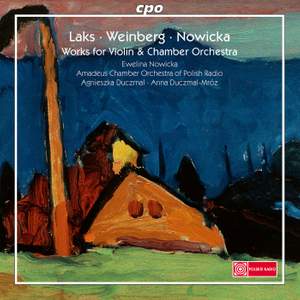Simon Laks, Mieczyslaw Weinberg & Ewelina Nowicka: Works for Violin & Chamber Orchestra
Ewelina Nowicka, Amadeus Chamber Orchestra of Polish Radio, Agnieszka Duczmal, Anna Duczmal-Mróz
CD
$15.75Downloads
What are FLAC and MP3?Contents
Weinberg: Pieces (3) for Violin & Chamber Orchestra
Work length16:27
$4.00
$5.20
- Ewelina Nowicka
- Amadeus Chamber Orchestra of Polish Radio
- Anna Duczmal-Mróz
1. Nocturne
Track length7:18
$2.00
$2.60
2. Scherzo
Track length2:32
$1.00
$1.30
3. Traum von einer Puppe
Track length6:37
$1.00
$1.30
Laks: Poeme for Violin and Orchestra
Work length16:27
$4.00
$5.15
- Ewelina Nowicka
- Amadeus Chamber Orchestra of Polish Radio
- Agnieszka Duczmal
4. Poème for Violin & Chamber Orchestra
Track length16:27
$4.00
$5.15
Nowicka: Kaddish 1944
Work length13:25
$3.00
$3.85
- Ewelina Nowicka
- Amadeus Chamber Orchestra of Polish Radio
- Agnieszka Duczmal
5. Kaddish 1944 for Violin & Chamber Orchestra
Track length13:25
$3.00
$3.85
Laks: Symphony for Strings
Work length19:44
$4.00
$5.20
- Ewelina Nowicka
- Amadeus Chamber Orchestra of Polish Radio
- Anna Duczmal-Mróz
6. Allegro energico
Track length6:31
$1.00
$1.30
7. Andante sostenuto
Track length5:28
$1.00
$1.30
8. Scherzo
Track length3:55
$1.00
$1.30
9. Finale. Allegro molto
Track length3:50
$1.00
$1.30





